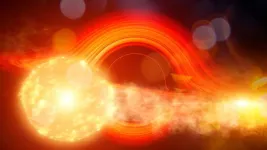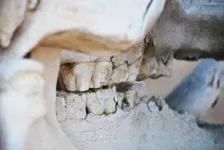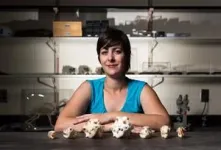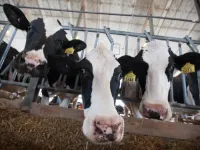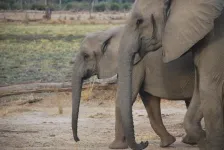(Press-News.org) Using NASA’s Neil Gehrels Swift Observatory, which launched in 2004, scientists have discovered a black hole in a distant galaxy repeatedly nibbling on a Sun-like star. The object heralds a new era of Swift science made possible by a novel method for analyzing data from the satellite’s X-ray Telescope (XRT).
“Swift’s hardware, software, and the skills of its international team have enabled it to adapt to new areas of astrophysics over its lifetime,” said Phil Evans, an astrophysicist at the University of Leicester in the United Kingdom and longtime Swift team member. “Neil Gehrels, the mission’s namesake, oversaw and encouraged many of those transitions. Now, with this new ability, it’s doing even more cool science.”
Evans led a study about the unlucky star and its hungry black hole, collectively called Swift J023017.0+283603 (or Swift J0230 for short), which was published on Sept. 7 in Nature Astronomy.
When a star strays too close to a monster black hole, gravitational forces create intense tides that break the star apart into a stream of gas. The leading edge swings around the black hole, and the trailing edge escapes the system. These destructive episodes are called tidal disruption events. Astronomers see them as flares of multiwavelength light created when the debris collides with a disk of material already orbiting the black hole.
Recently, astronomers have been investigating variations on this phenomena, which they call partial or repeating tidal disruptions.
During these events, every time an orbiting star passes close to a black hole, the star bulges outward and sheds material, but survives. The process repeats until the star loses too much gas and finally breaks apart. The characteristics of the individual star and black hole system determine what kind of emission scientists observe, creating a wide array of behaviors to categorize.
Previous examples include an outburst that occurred every 114 days, potentially caused by a giant star orbiting a black hole with 78 million times the Sun’s mass. Another recurred every nine hours around a black hole with 400,000 times the Sun’s mass, likely caused by an orbiting stellar cinder called a white dwarf.
On June 22, 2022, the XRT captured Swift J0230 for the first time. It lit up in a galaxy around 500 million light-years away in the northern constellation Triangulum. Swift’s XRT observed nine additional outbursts from the same location roughly every few weeks.
Evans and his team propose that Swift J0230 is a repeating tidal disruption of a Sun-like star orbiting a black hole with over 200,000 times the Sun’s mass. They estimate the star loses around three Earth masses of material on each pass. This system provides a bridge between other types of suspected repeating disruptions and allowed scientists to model how interactions between different star types and black hole sizes affect what we observe.
“We searched and searched for the event brightening in the data collected by Swift’s Ultraviolet/Optical Telescope,” said Alice Breeveld, a research fellow at the University College London’s Mullard Space Science Laboratory (MSSL) who has worked on the instrument since before the satellite launched. “But there wasn’t any sign of it. The galaxy’s variability was entirely in X-rays. That helped rule out some other potential causes.”
Swift J0230’s discovery was possible thanks to a new, automated search of XRT observations, developed by Evans, called the Swift X-ray Transient Detector.
After the instrument observes a portion of the sky, the data is transmitted to the ground, and the program compares it to previous XRT snapshots of the same spot. If that portion of the X-ray sky has changed, scientists get an alert. In the case of Swift J0230, Evans and his colleagues were able to rapidly coordinate additional observations of the region.
Swift was originally designed to study gamma-ray bursts, the most powerful explosions in the cosmos. Since the satellite launched, however, scientists have recognized its ability to study a whole host of celestial objects, like tidal disruptions and comets.
“Swift J0230 was discovered only about two months after Phil launched his program,” said S. Bradley Cenko, the mission’s principal investigator at NASA’s Goddard Space Flight Center in Greenbelt, Maryland. “It bodes well for the detector’s ability to identify other transient events and for Swift’s future exploring new spaces of science.”
Goddard manages the Swift mission in collaboration with Penn State, the Los Alamos National Laboratory in New Mexico, and Northrop Grumman Space Systems in Dulles, Virginia. Other partners include Leicester, MSSL, Brera Observatory in Italy, and the Italian Space Agency.
END
NASA’s Swift learns a new trick, spots a snacking black hole
2023-09-07
ELSE PRESS RELEASES FROM THIS DATE:
U of M study suggests hepatitis C patients should consider revaccination for hepatitis B
2023-09-07
MINNEAPOLIS/ST. PAUL (09/07/2023) — Recently published research from the University of Minnesota Medical School suggests individuals with hepatitis C should consider revaccination for hepatitis B. The study was published in the Journal of Infectious Diseases.
Previous research has shown individuals with hepatitis C infection have a lower response to the hepatitis B virus (HBV) vaccine.
“This study has broad implications for public health in hepatitis-infected individuals,” said Jose Debes, MD, PhD, an ...
NYU Tandon School of Engineering researchers develop hurricane power outage prediction model that outperforms traditional methods
2023-09-07
Utility companies are generally well-equipped to handle routine blackouts, but often struggle with extreme weather events like hurricanes.
Conventional hurricane power-outage prediction models often produce incomplete or incorrect results, hampering companies’ abilities to prepare to restore power as quickly as possible, especially in cities that are susceptible to prolonged hurricane-induced power outages.
New research from NYU Tandon School of Engineering may help solve that problem.
By combining wind speed and precipitation ...
Cattle on low-protein rations may need amino acid supplement to boost milk yield
2023-09-07
UNIVERSITY PARK, Pa. — When dairy cows are fed diets with reduced protein concentrations — aimed at decreased environmental nitrogen pollution from their manure such as nitrate leaching, nutrient-laden run-off and ammonia volatilization — their milk production can suffer. Supplementing the amino acid histidine may help in maintaining, and even increasing, milk and milk-protein yields.
That’s the conclusion of a new study conducted by an international research team led by Alexander Hristov, Penn State distinguished ...
"Monstrous births” and the making of race in the nineteenth-century United States
2023-09-07
From the Middle Ages to the Enlightenment, “monstrous births”—malformed or anomalous fetuses—were, to Western medicine, an object of superstition. In 19th-century America, they became instead an object of the “modern scientific study of monstrosity,” a field formalized by French scientist Isidore Geoffroy Saint-Hilaire. This clinical turn was positioned against the backdrop of social, political, and economic activity that codified laws governing slavery, citizenship, immigration, family, ...
Moral reasoning displays characteristic patterns in the brain
2023-09-07
(Santa Barbara, Calif.) — Every day we encounter circumstances we consider wrong: a starving child, a corrupt politician, an unfaithful partner, a fraudulent scientist. These examples highlight several moral issues, including matters of care, fairness and betrayal. But does anything unite them all?
Philosophers, psychologists and neuroscientists have passionately argued whether moral judgments share something distinctive that separates them from non-moral matters. Moral monists claim that morality is unified by a common characteristic and that all moral issues involve concerns about harm. Pluralists, in contrast, argue that moral ...
Echoes of extinctions: novel method unearths disruptions in mammal trait-environment relationships
2023-09-07
Large-bodied mammals play crucial roles in ecosystems. They create habitats, serve as prey, help plants thrive, and even influence how wildfires burn. But now, fewer than half of the large mammal species that were alive 50,000 years ago exist today, and those that remain are threatened with extinction from intensifying climate change and human activities.
While mammal extinctions are well-documented, very little research has explored the impact those losses had on the nuanced ways in which mammal communities interact with their environments. Researchers at the Georgia Institute of Technology are using a novel methodology to investigate how mammals’ ability to function in their environments ...
Specialized T cells in the brain slow progression of Alzheimer’s disease
2023-09-07
(MEMPHIS, Tenn. – September 07, 2023) As many as 5.8 million Americans are currently living with Alzheimer’s disease, a neurodegenerative condition associated with progressive cognitive decline, including loss of memory capabilities . Protein aggregates, composed of beta-amyloid or other proteins, form in the brains of individuals with Alzheimer’s. These beta-amyloid plaques appear to be a significant contributor to the disease. St. Jude Children’s Research Hospital scientists uncovered a subset of immune cells that appears to slow this beta-amyloid plaque accumulation ...
KERI, transfer of ‘ion implantation evaluation technology for the SiC power semiconductor’ to Hungary
2023-09-07
KERI succeeded in transferring the ‘Ion Implantation and its Evaluation Technology for the SiC (silicon carbide) Power Semiconductor’ to a Hungarian company.
Power semiconductors are key components in electricity and electronics, acting as the muscles of the human body by regulating the direction of current and controlling power conversion. There are many different materials for power semiconductors. Among them, SiC is receiving the most attention due to its excellent material properties, including high durability and excellent power efficiency. When SiC power ...
VCU liver institute director leads review of noninvasive tests that could be alternatives to painful biopsies
2023-09-07
By A.J. Hostetler
Led by the director of Virginia Commonwealth University’s Stravitz-Sanyal Institute of Liver Disease and Metabolic Health, a consortium studying noninvasive tests for liver disease has demonstrated the effectiveness of five noninvasive tests, a significant milestone on the path to regulatory approval.
In an article published today in the journal Nature Medicine, institute director Arun Sanyal, M.D., a professor at the VCU School of Medicine, and colleagues report on five biomarker tests that potentially could be given to patients who may have ...
Early access to testosterone therapy in transgender and gender-diverse adults seeking masculinization
2023-09-07
About The Study: In this randomized clinical trial including 64 transgender and gender-diverse adults, immediate testosterone therapy compared with no treatment significantly reduced gender dysphoria, depression, and suicidality in transgender and gender-diverse individuals desiring testosterone therapy.
Authors: Ada S. Cheung, M.B.B.S., Ph.D., of Austin Health in Heidelberg, Victoria, Australia, is the corresponding author.
To access the embargoed study: Visit our For The Media website at this link https://media.jamanetwork.com/
(doi:10.1001/jamanetworkopen.2023.31919)
Editor’s Note: Please see the article for ...
